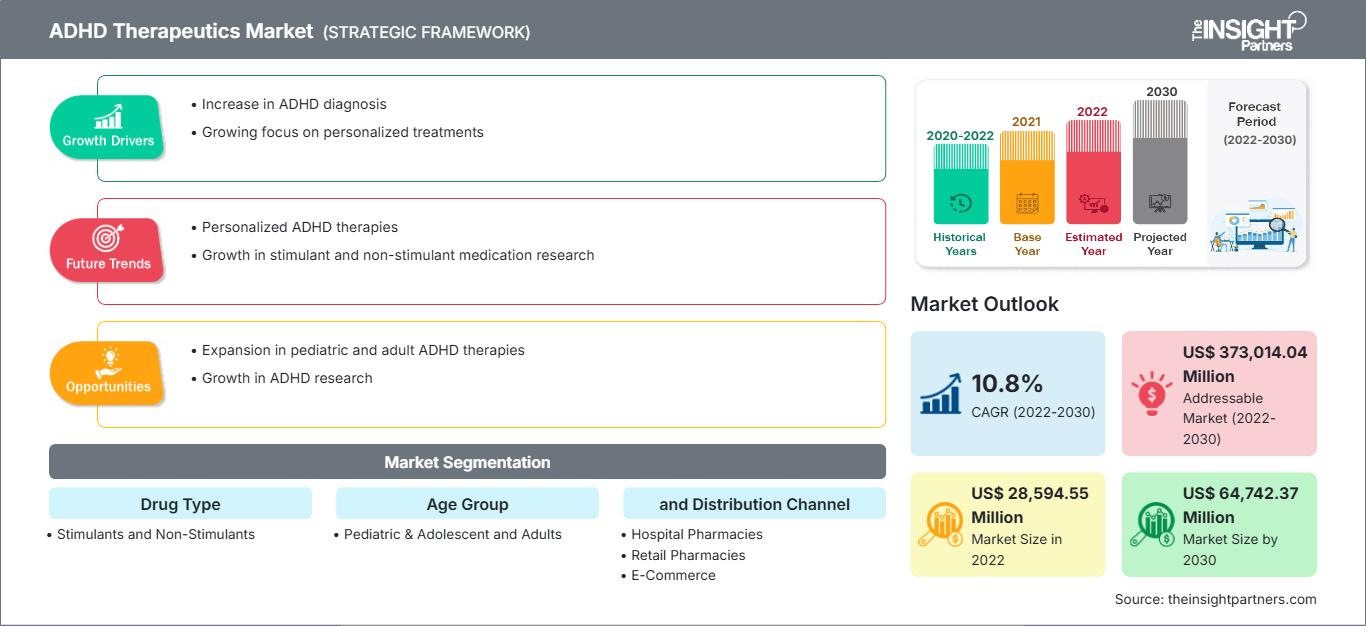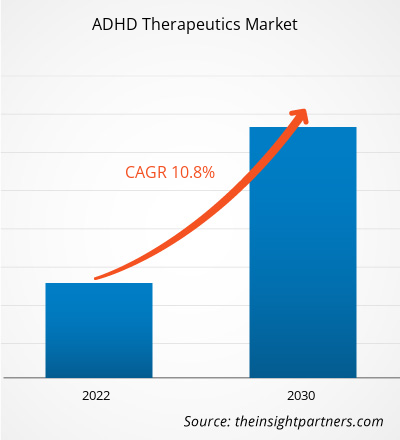[Rapporto di ricerca] Il mercato delle terapie per l'ADHD è stato valutato a 28.594,55 milioni di dollari nel 2022 e si prevede che raggiungerà i 64.742,37 milioni di dollari entro il 2030; si stima che registrerà un CAGR del 10,8% tra il 2022 e il 2030.
Approfondimenti di mercato e punto di vista degli analisti:
Il disturbo da deficit di attenzione/iperattività (ADHD) è un disturbo complesso dello sviluppo neurologico che colpisce la capacità degli individui di concentrarsi, controllare i comportamenti impulsivi e gestire l'iperattività. Viene diagnosticato principalmente durante l'infanzia, ma i sintomi possono persistere nell'adolescenza e nell'età adulta. Il trattamento dell'ADHD spesso prevede un approccio multidisciplinare, che include terapia comportamentale, educazione e farmaci, sia stimolanti che non stimolanti.
Fattori come la crescente prevalenza dell'ADHD e l'aumento della domanda di farmaci per il trattamento stimolano la crescita del mercato. Tuttavia, gli effetti collaterali associati ai farmaci per l'ADHD e la loro limitata efficacia ostacolano la crescita del mercato delle terapie per l'ADHD.
Fattori e ostacoli alla crescita:
Secondo l'articolo pubblicato dai Centers for Disease Control and Prevention (CDC), nel febbraio 2022, circa 6 milioni di bambini di età compresa tra 3 e 17 anni negli Stati Uniti hanno ricevuto una diagnosi di ADHD, pari al 9,8% della popolazione tra il 2016 e il 2019. Inoltre, secondo un articolo pubblicato da PubMed Central nel 2022, l'ADHD colpisce il 5-7,2% dei bambini e il 2,5-6,7% degli adulti in tutto il mondo. Secondo stime recenti, la frequenza tra gli adolescenti negli Stati Uniti è molto più elevata, attestandosi a circa l'8,7%, ovvero 5,3 milioni. Sebbene sia stata tradizionalmente considerata una condizione infantile, fino al 90% dei bambini con ADHD continua a manifestare sintomi in età adulta. È possibile diagnosticare l'ADHD anche negli adulti, poiché secondo uno studio, il 75% degli individui con ADHD non ha ricevuto una diagnosi pregressa durante l'infanzia. L'ADHD è spesso associato a condizioni di comorbilità come ansia, depressione, disturbi dell'apprendimento e abuso di sostanze. La presenza di queste comorbilità aumenta la complessità del trattamento, rendendo necessario un approccio multidimensionale che affronti sia i sintomi dell'ADHD sia le condizioni associate. Sono raccomandati farmaci come psicostimolanti e non stimolanti, che possono aiutare i bambini a gestire i sintomi dell'ADHD nella vita quotidiana e a regolare comportamenti che possono causare difficoltà in vari aspetti della loro vita, tra cui la vita personale e il rendimento scolastico. Pertanto, i fattori sopra menzionati stanno aumentando la domanda di farmaci indicati per l'ADHD, facilitando l'espansione della quota di mercato delle terapie per l'ADHD.
Tuttavia, la crescita del mercato delle terapie per l'ADHD è limitata a causa del limitato sollievo dai sintomi e degli effetti collaterali associati all'uso di tali farmaci. Gli effetti collaterali comuni dei farmaci psicostimolanti includono diminuzione dell'appetito, insonnia, aumento dell'ansia, maggiore irritabilità, mal di stomaco e mal di testa. Quando l'effetto del farmaco svanisce, i sintomi dell'ADHD possono ripresentarsi, causando un effetto "rebound" che può essere più intenso.
Personalizza questo rapporto in base alle tue esigenze
Potrai personalizzare gratuitamente qualsiasi rapporto, comprese parti di questo rapporto, o analisi a livello di paese, pacchetto dati Excel, oltre a usufruire di grandi offerte e sconti per start-up e università
Mercato delle terapie per l'ADHD: Approfondimenti strategici

-
Ottieni le principali tendenze chiave del mercato di questo rapporto.Questo campione GRATUITO includerà l'analisi dei dati, che vanno dalle tendenze di mercato alle stime e alle previsioni.
Segmentazione e ambito del rapporto:
L'analisi di mercato delle terapie per l'ADHD è stata condotta considerando i seguenti segmenti: tipo di farmaco, fascia d'età e canale di distribuzione.
Analisi segmentale:
Il mercato delle terapie per l'ADHD, per tipo di farmaco, è segmentato in farmaci stimolanti e farmaci non stimolanti.
Il segmento dei farmaci stimolanti ha detenuto una quota di mercato maggiore delle terapie per l'ADHD nel 2022 e si prevede che registrerà un CAGR più elevato nel periodo 2022-2030.
Mercato delle terapie per l'ADHD per tipo di farmaco - 2022 e 2030
In base alla fascia d'età, il mercato delle terapie per l'ADHD è segmentato in pediatrico e adolescenziale e adulto. Il segmento pediatrico e adolescenziale ha detenuto una quota di mercato maggiore nel 2022. Si prevede che il segmento adulto registrerà un CAGR più elevato dal 2022 al 2030.
In termini di canale di distribuzione, il mercato delle terapie per l'ADHD è suddiviso in farmacie ospedaliere, farmacie al dettaglio ed e-commerce. Nel 2022, il segmento delle farmacie ospedaliere ha detenuto la quota di mercato maggiore e si prevede che registrerà il CAGR più elevato tra il 2022 e il 2030.
Analisi regionale:
Nord America, Europa, Asia Pacifico, America meridionale e centrale e Medio Oriente e Africa L'Africa è la principale regione analizzata per ricavare l'ambito del rapporto sul mercato delle terapie per l'ADHD.
Nel 2022, il Nord America deteneva la maggiore quota di mercato globale. In Nord America, gli Stati Uniti detenevano la quota maggiore del mercato nel 2022 e si stima che manterranno il loro dominio dal 2022 al 2030. La crescita del mercato delle terapie per l'ADHD è in gran parte dovuta all'elevata prevalenza dell'ADHD negli Stati Uniti. Secondo Cingulate, nel 2022 a circa 6,4 milioni di bambini e adolescenti di età compresa tra 4 e 17 anni è stato diagnosticato l'ADHD. Tra questi, oltre l'80% di questo gruppo riceve un trattamento e circa il 65% manifesta sintomi di ADHD persistenti fino all'età adulta. Inoltre, si prevede che la crescita del mercato sarà trainata da una migliore accessibilità economica per i pazienti, politiche di rimborso favorevoli e una maggiore consapevolezza dei farmaci attuali.
L'Asia-Pacifico è il mercato in più rapida crescita per l'ADHD grazie alla presenza di attori chiave nella regione e a diverse iniziative strategiche intraprese per sviluppare e commercializzare nuovi prodotti. Ad esempio, a giugno 2020, Otsuka Pharmaceutical Co., Ltd. e Otsuka Pharmaceutical Development & Commercialization, Inc. hanno riportato risultati positivi dai loro due studi clinici di fase 3 di sei settimane che hanno valutato l'efficacia, la sicurezza e la tollerabilità della centanafadina orale. La centanafadina è un nuovo farmaco sperimentale progettato per il trattamento di pazienti adulti con diagnosi di ADHD. L'azienda ha inoltre pianificato di studiare gli effetti della centanafadina nei bambini con ADHD e di discutere i prossimi passi con la Food and Drug Administration statunitense.
Sviluppi del settore e opportunità future:
Le previsioni di mercato delle terapie per l'ADHD possono aiutare gli stakeholder di questo mercato a pianificare le proprie strategie di crescita. Di seguito sono elencate le iniziative intraprese dai principali attori del mercato:
- A settembre 2023, Cingulate Inc. ha annunciato i risultati del suo studio di Fase 3 sull'efficacia e la sicurezza negli adulti del suo principale candidato, CTx-1301 (dexmetilfenidato), per il trattamento dell'ADHD. L'azienda utilizza Precision Timed Release (PTR), la sua tecnologia brevettata per la somministrazione di farmaci, per costruire e sviluppare una pipeline di prodotti farmaceutici di nuova generazione. I risultati sono stati presentati l'8 settembre al 36° Congresso Annuale di Psichiatria a Nashville, Tennessee.
- A marzo 2022, Noven Pharmaceuticals, Inc., una consociata interamente controllata da Hisamitsu Pharmaceutical Co., Inc., ha ottenuto l'approvazione dalla Food and Drug Administration (FDA) statunitense per il suo sistema transdermico XELSTRYM (destroamfetamina), CII, per il trattamento dell'ADHD negli adulti e nei pazienti pediatrici dai sei anni in su.
- A luglio 2021, Corium, Inc. ha lanciato AZSTARYS. Questo farmaco innovativo combina serdexmetilfenidato (SDX) e dexmetilfenidato (d-MPH) negli Stati Uniti per il trattamento sintomatico nei pazienti dai 6 anni in su. AZSTARYS ha ottenuto l'approvazione della FDA nel marzo 2021. È composto da una combinazione di due tipi di farmaci: il 70% di profarmaco a rilascio prolungato di d-MPH SDX (Schedule IV) e il 30% di d-MPH a rilascio immediato (Schedule II).
- Nell'aprile 2021, Supernus Pharmaceuticals, Inc. ha annunciato che la FDA statunitense aveva approvato Qelbree (capsule a rilascio prolungato di viloxazina) per il trattamento dell'ADHD in pazienti di età compresa tra 6 e 17 anni.
Panorama competitivo e aziende chiave:
Amneal Pharmaceuticals, Inc.; Novartis AG; Pfizer, Inc.; Eli Lilly and Company; Noven Pharmaceuticals, Inc.; Janssen Pharmaceuticals, Inc.; Johnson & Johnson Services, Inc.; Corium Inc; Adlon Therapeutics LP; e Teva Pharmaceutical Industries Ltd. sono tra i principali attori descritti nel rapporto di mercato sulle terapie per l'ADHD. Queste aziende adottano strategie di sviluppo prodotto per soddisfare la crescente domanda dei clienti, il che consente loro di mantenere il proprio marchio.
Approfondimenti regionali sul mercato delle terapie per l'ADHD
Le tendenze regionali e i fattori che influenzano il mercato delle terapie per l'ADHD durante il periodo di previsione sono stati ampiamente spiegati dagli analisti di The Insight Partners. Questa sezione illustra anche i segmenti e la geografia del mercato delle terapie per l'ADHD in Nord America, Europa, Asia-Pacifico, Medio Oriente e Africa, America Meridionale e Centrale.
Ambito del rapporto di mercato sulle terapie per l'ADHD
| Attributo del rapporto | Dettagli |
|---|---|
| Dimensioni del mercato in 2022 | US$ 28,594.55 Million |
| Dimensioni del mercato per 2030 | US$ 64,742.37 Million |
| CAGR globale (2022 - 2030) | 10.8% |
| Dati storici | 2020-2022 |
| Periodo di previsione | 2022-2030 |
| Segmenti coperti |
By Tipo di farmaco
|
| Regioni e paesi coperti |
Nord America
|
| Leader di mercato e profili aziendali chiave |
|
Densità degli operatori del mercato delle terapie per l'ADHD: comprendere il suo impatto sulle dinamiche aziendali
Il mercato dei farmaci per l'ADHD è in rapida crescita, trainato dalla crescente domanda degli utenti finali, dovuta a fattori quali l'evoluzione delle preferenze dei consumatori, i progressi tecnologici e una maggiore consapevolezza dei benefici del prodotto. Con l'aumento della domanda, le aziende stanno ampliando la propria offerta, innovando per soddisfare le esigenze dei consumatori e sfruttando le tendenze emergenti, alimentando ulteriormente la crescita del mercato.

- Ottieni il Mercato delle terapie per l'ADHD Panoramica dei principali attori chiave
- Analisi storica (2 anni), anno base, previsione (7 anni) con CAGR
- Analisi PEST e SWOT
- Valore/volume delle dimensioni del mercato - Globale, Regionale, Nazionale
- Industria e panorama competitivo
- Set di dati Excel
Report recenti
Testimonianze
Motivo dell'acquisto
- Processo decisionale informato
- Comprensione delle dinamiche di mercato
- Analisi competitiva
- Analisi dei clienti
- Previsioni di mercato
- Mitigazione del rischio
- Pianificazione strategica
- Giustificazione degli investimenti
- Identificazione dei mercati emergenti
- Miglioramento delle strategie di marketing
- Aumento dell'efficienza operativa
- Allineamento alle tendenze normative






















 Ottieni un campione gratuito per - Mercato delle terapie per l'ADHD
Ottieni un campione gratuito per - Mercato delle terapie per l'ADHD